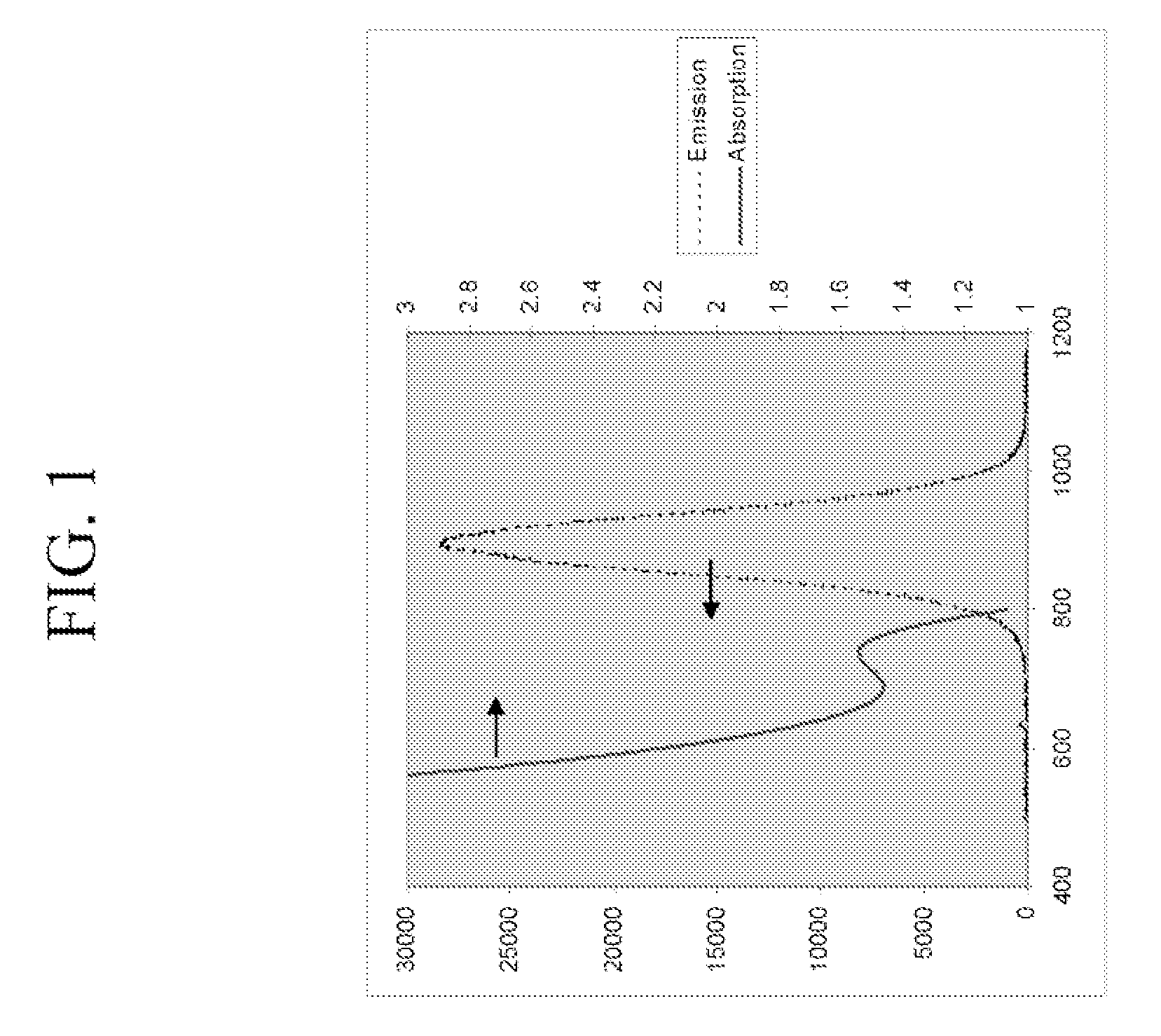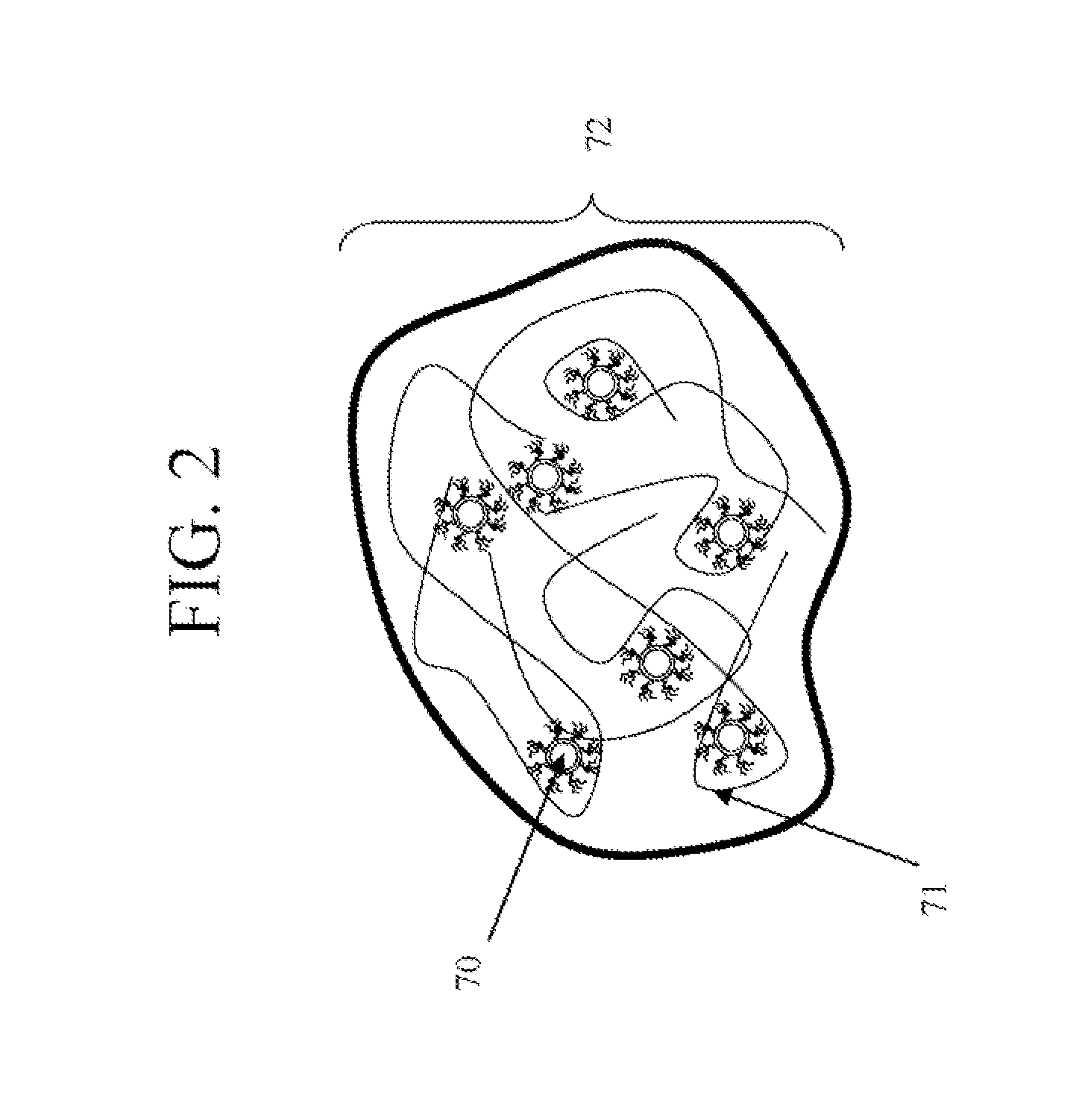Quantum dot fluorescent inks
a fluorescent ink and quantum dot technology, applied in the field of inks, can solve the problems of limited protection against copying, difficulty in dispersing hydrophobic semiconductor nanomaterials into water without significant sedimentation, and low light fastness and water fastness of printed materials
- Summary
- Abstract
- Description
- Claims
- Application Information
AI Technical Summary
Benefits of technology
Problems solved by technology
Method used
Image
Examples
example 1
[0067]The present example relates to PbS quantum dots dispersed in polyester. A commercial aqueous solution of Integrity 1100D supplied by Hexion Specialty Chemicals with the general structure of:[0068]-A-GGG-A-GGG-A-
[0069]wherein each A is a sulfonated dicarboxylic acid and each GGG is a poly(glycol) chain, was dried overnight at 373° C. The molecular weight of the polymer was 15000 with a Tg of 5.
[0070]After drying, the solid resin was ground into a 0.5 mm powder and 0.5 g of the powder was dissolved into 15 mL of dichloromethane. The solution was then stirred for 15 minutes to form a thick gel-like mixture. Then varying amounts (ranging from 5 mg to 30 mg) of a 13.3 mg / mL toluene solution of PbS quantum dots supplied by Evident Technologies which had a first absorption peak at 730 nm and a peak fluorescent wavelength at 890 nm were added to the mixture and stirred for one hour. Afterward, the solvent was evaporated under reduced pressure at 55° C. for about 5 hours. The dried res...
example 2
[0071]The present example relates to CdSe quantum dots dispersed in polyester. The solid resin described in Example 1 was used in this example as well. Varying amounts (ranging from 0.5 mg to 10 mg) of an 8.2 mg / mL toluene solution of CdSe quantum dots supplied by Evident Technologies which absorbs light at 531 nm and fluoresces at 558 nm were added to the mixture and stirred for one hour. Afterward, the solvent was evaporated under reduced pressure at 55° C. for about 5 hours. The dried resin was re-dissolved in water in the concentration range of about 5 to 25% as needed during the ink formulation process. The visible fluorescence activity of the resin was confirmed by changes in color of samples prepared on microscope slides, illuminating them with a UV light that emitted ultraviolet radiation at 375 nm.
[0072]Though the resin used in this example was Integrity 1100D, other water-dispersible polyesters are similarly applicable using this preparation. For example, suitable polyeste...
example 3
[0073]The present example relates to PbS dispersed in styrene-acrylate. 2 g of a glycol-free styrene-acrylic solid resin (Tg of 105° C. and supplied by Neoresin) was dissolved in 8 g of acetone. Afterward, 2 mL of a 13.3 mg / mL chloroform solution of PbS quantum dots which absorbs light at 730 nm and fluoresces at 890 nm was added to this mixture. Then the solvent was decanted and the precipitated gel was dried in an oven overnight at 55° C. This process gave a 1.17 g yield.
[0074]Finally, 0.97 g of the dried resin was mixed with 10 mL of water and heated to 80° C. Then, a 40 wt % solution of Dimethylamine was added to the mixture until it reached a pH of 9.5. A brown solution was formed after 1 hour. To verify that the quantum dots still maintained fluorescence emission, a small amount of the brown solution was cast onto glass slides and then dried overnight to form a clear brown film. The near infrared fluorescence activity of the resin was confirmed with night vision goggles during...
PUM
 Login to View More
Login to View More Abstract
Description
Claims
Application Information
 Login to View More
Login to View More - R&D
- Intellectual Property
- Life Sciences
- Materials
- Tech Scout
- Unparalleled Data Quality
- Higher Quality Content
- 60% Fewer Hallucinations
Browse by: Latest US Patents, China's latest patents, Technical Efficacy Thesaurus, Application Domain, Technology Topic, Popular Technical Reports.
© 2025 PatSnap. All rights reserved.Legal|Privacy policy|Modern Slavery Act Transparency Statement|Sitemap|About US| Contact US: help@patsnap.com



